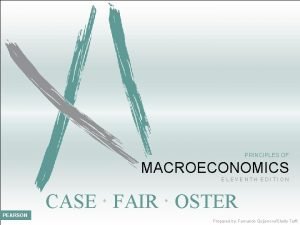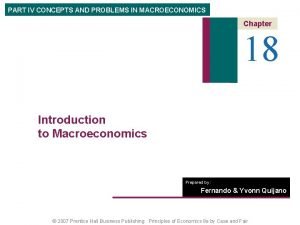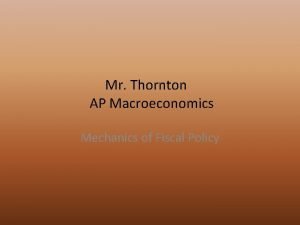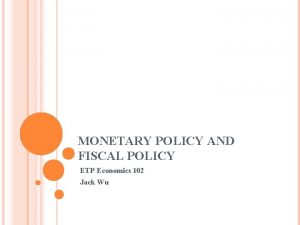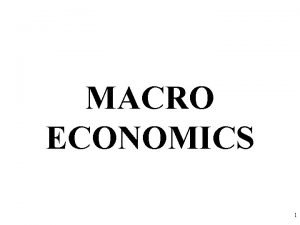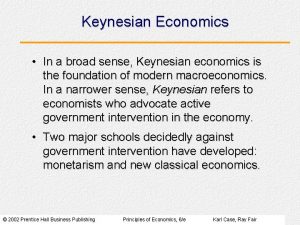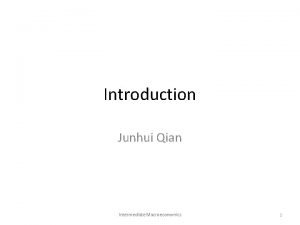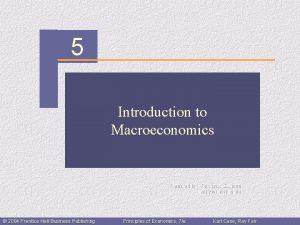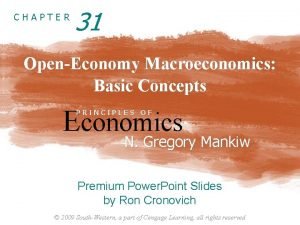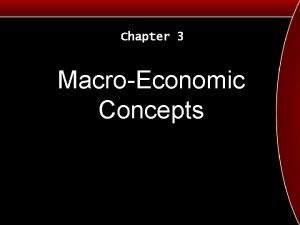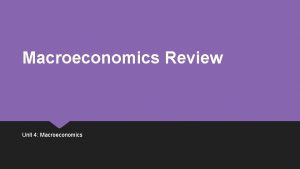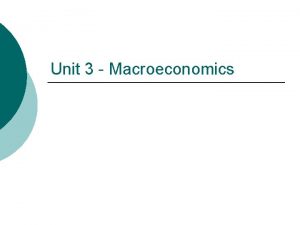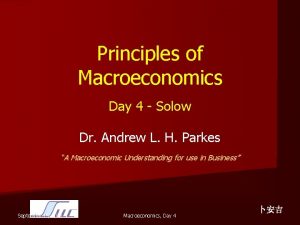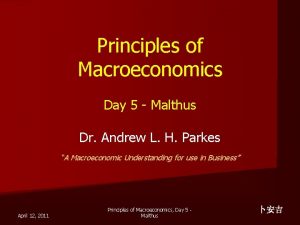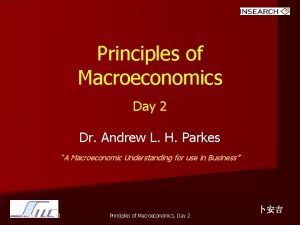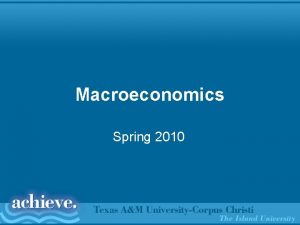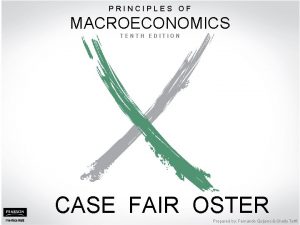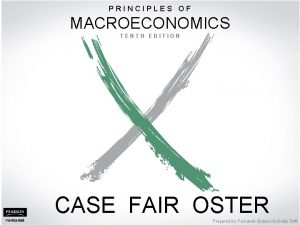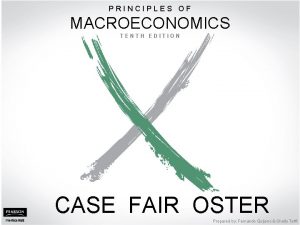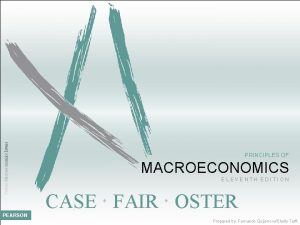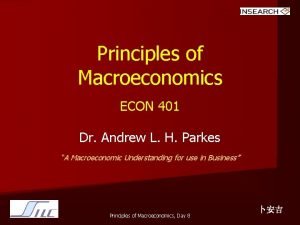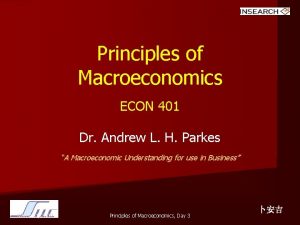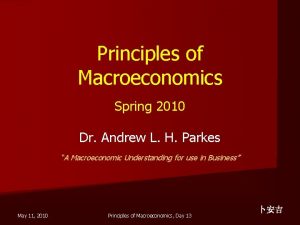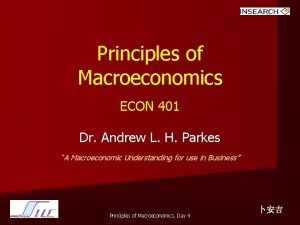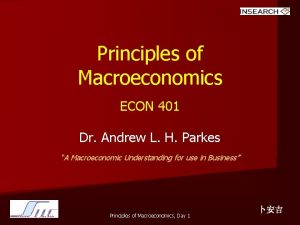Principles of Macroeconomics Day 5 Dr Andrew L




















- Slides: 20

Principles of Macroeconomics Day 5 Dr. Andrew L. H. Parkes “A Macroeconomic Understanding for use in Business” September 21, 2010 Principles of Macroeconomics, Day 5 卜安吉

http: //krugman. blogs. nytimes. com/2010/09/15/its-demand-stupid/ September 21, 2010 Principles of Macroeconomics, Day 5 2

In this chapter, look for the answers to these questions: n What are the main types of financial institutions in the U. S. economy, and what is their function? n What are three kinds of saving? n What’s the difference between saving and investment? n How does the financial system coordinate saving and investment? n How do gov’t policies affect saving, investment, and the interest rate? September 21, 2010 Principles of Macroeconomics, Day 5 3

Financial Institutions The financial system: the group of institutions that helps match the saving of one person with the investment of another. n Financial markets: institutions through which savers can directly provide funds to borrowers. Examples: n – The Bond Market. A bond is a certificate of indebtedness. – The Stock Market. A stock is a claim to partial ownership in a firm. September 21, 2010 Principles of Macroeconomics, Day 5 4

Financial Institutions n Financial intermediaries: institutions through which savers can indirectly provide funds to borrowers. Examples: – Banks – Mutual funds – institutions that sell shares to the public and use the proceeds to buy portfolios of stocks and bonds September 21, 2010 Principles of Macroeconomics, Day 5 5

Different Kinds of Saving Private saving = The portion of households’ income that is not used for consumption or paying taxes =Y – T – C Public saving = Tax revenue less government spending =T–G September 21, 2010 Principles of Macroeconomics, Day 5 6

National Saving National saving = private saving + public saving = ( Y – T – C) + = ( T – G) Y – C – G = the portion of national income that is not used for consumption or government purchases September 21, 2010 Principles of Macroeconomics, Day 5 7

Saving and Investment Recall the national income accounting identity: Y = C + I + G + NX For now focus on the closed economy case: Y=C+I+G Solve for I: I = Y–C–G national saving = (Y – T – C) + (T – G) Saving = investment in a closed economy September 21, 2010 Principles of Macroeconomics, Day 5 8

Budget Deficits and Surpluses Budget surplus = an excess of tax revenue over govt spending = T–G = public saving Budget deficit = a shortfall of tax revenue from govt spending = G–T = – (public saving) September 21, 2010 Principles of Macroeconomics, Day 5 9

ACTIVE LEARNING A. Calculations 1 n. Suppose GDP equals $11 trillion, consumption equals $7. 3 trillion, the government spends $2. 2 trillion, transfers are zero, and has a budget deficit of $500 billion. n. Find public saving, taxes, private saving, national saving, and investment. September 21, 2010 Principles of Macroeconomics, Day 5 10 10

ACTIVE LEARNING 1 B. How a tax cut affects saving Use the numbers from the preceding exercise, but suppose now that the government cuts taxes by $300 billion. n In each of the following two scenarios, determine what happens to public saving, private saving, national saving, and investment. n 1. Consumers save the full proceeds of the tax cut. 2. Consumers save 1/3 of the tax cut and spend the other 2/3. September 21, 2010 Principles of Macroeconomics, Day 5 11 11

ACTIVE LEARNING 1 C. Discussion questions The two scenarios from this exercise were: 1. Consumers save the full proceeds of the tax cut. 2. Consumers save 1/3 of the tax cut and spend the other 2/3. n. Which of these two scenarios do you think is more realistic? n. Why is this question important? September 21, 2010 Principles of Macroeconomics, Day 5 12 12

SPACE September 21, 2010 Principles of Macroeconomics, Day 5 13

September 21, 2010 Principles of Macroeconomics, Day 5 14

ACTIVE LEARNING Answers, part A Given: Y = 11. 0, C = 7. 3, 1 G = 2. 2, G – T = 0. 5 Public saving = T – G = – 0. 5 Taxes: T = G – 0. 5 = 1. 7 Private saving = Y – T – C = 11 – 1. 7 – 7. 3 = 2. 0 National saving = Y – C – G = 11 – 7. 3 – 2. 2 = 1. 5 Investment = national saving = 1. 5 September 21, 2010 Principles of Macroeconomics, Day 5 15 15

ACTIVE LEARNING Answers, part B 1 In both scenarios, public saving falls by $300 billion, and the budget deficit rises from $500 billion to $800 billion. 1. If consumers save the full $300 billion, national saving is unchanged, so investment is unchanged. 2. If consumers save $100 billion and spend $200 billion, then national saving and investment each fall by $200 billion. September 21, 2010 Principles of Macroeconomics, Day 5 16 16

Public Policies n Tax Policies – – incentives which increase or decrease the price n Spending Policies – – incentives which increase the amount of money n Spending policies right now are called “Stimulus” Packages by most governments September 21, 2010 Principles of Macroeconomics, Day 5 17

Public Policies n These are very simple generalizations – However they will give you some idea of why the two political parties in America do not agree, and – May help you to understand why the Republican Party is whining so much … September 21, 2010 Principles of Macroeconomics, Day 5 18

Public Policies n In America today, the Conservative or Republican Party (GOP) is in the minority or opposition. – They are against all taxes – For minimal government – justice system mostly, that is to support private property – Pro – Business – usually support most business organizations September 21, 2010 Principles of Macroeconomics, Day 5 19

Public Policies n In America today, the Liberal or Democratic Party is in the majority or in power. – They are against taxes on the middle class – For a regulatory government – helping keep the businesses from dominating consumers – Support business interests yet not big conglomerate multinationals, to some degree September 21, 2010 Principles of Macroeconomics, Day 5 20
 Day 1 day 2 day 3 day 4
Day 1 day 2 day 3 day 4 Day 1 day 2 day 817
Day 1 day 2 day 817 Principles of macroeconomics case fair oster
Principles of macroeconomics case fair oster Macroeconomics examples
Macroeconomics examples Components of macroeconomics
Components of macroeconomics Crowding out effect macroeconomics
Crowding out effect macroeconomics Crowding out effect macroeconomics
Crowding out effect macroeconomics Unit 5 macroeconomics lesson 2 activity 45
Unit 5 macroeconomics lesson 2 activity 45 Limitations of macroeconomics
Limitations of macroeconomics Cyclical unemployment diagram
Cyclical unemployment diagram Micro economic examples
Micro economic examples What is macroeconomics
What is macroeconomics New classical macroeconomics
New classical macroeconomics New classical macroeconomics
New classical macroeconomics Crowding out effect of fiscal policy
Crowding out effect of fiscal policy 2012 macroeconomics frq
2012 macroeconomics frq How to calculate gdp from circular flow diagram
How to calculate gdp from circular flow diagram Ap macroeconomics-percentage for a 5
Ap macroeconomics-percentage for a 5 Chapter 31 open economy macroeconomics
Chapter 31 open economy macroeconomics Macroeconomic deals withसमग्रलक्षी
Macroeconomic deals withसमग्रलक्षी Supply side economics
Supply side economics


